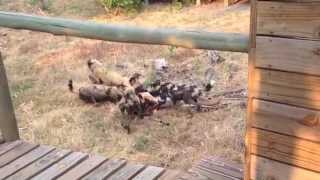On Friday, 24 June 1994, a United States Air Force (USAF) Boeing B-52 Stratofortress crashed at Fairchild Air Force Base, Washington, United States,[2] after its pilot, Lieutenant ColonelArthur “Bud” Holland, maneuvered the bomber beyond its operational limits and lost control. The aircraft stalled, fell to the ground and exploded, killing Holland and the other three crew aboard. The crash was captured on video and was shown repeatedly on news broadcasts throughout the world.

The subsequent investigation concluded that the crash was attributable primarily to three factors: Holland’s personality and behavior, USAF leaders’ delayed or inadequate reactions to earlier incidents involving Holland, and the sequence of events during the aircraft’s final flight. The crash is now used in military and civilian aviation environments as a case study in teaching crew resource management. It is also often used by the U.S. Armed Forces during aviation safety training as an example of the importance of compliance with safety regulations and correcting the behavior of anyone who violates safety procedures.
At 07:30 local time (PDT) on 24 June 1994, a United States Air Force (USAF) B-52H bomber crew stationed at Fairchild Air Force Base prepared to practice an aircraft demonstration flight for an airshow. The crew consisted of pilots Lieutenant Colonel Arthur “Bud” Holland (age 46), Lt Col Mark McGeehan (38), Colonel Robert Wolff (46), and weapon systems officer/radar navigator Lt Col Ken Huston (41). Holland was the designated aircraft commander for the flight. McGeehan was the copilot and Wolff was present as a safety observer. Holland was the chief of the 92nd Bomb Wing‘s Standardization and Evaluation branch, McGeehan was the commander of the 325th Bomb Squadron, Wolff was the vice commander of the 92nd Bomb Wing, and Huston was the 325th Bomb Squadron’s operations officer. Holland, as chief of standardization and evaluation, was responsible for the knowledge and enforcement of academic and in-flight standards for the bomb wing’s flying operations.[3][4]

The mission plan for the flight called for a demanding series of low-altitude passes, 60° banked turns, a steep climb, and a touch-and-go landing on Fairchild’s runway 23. The flight was also Wolff’s “finis flight” – a common tradition in which a retiring USAF aircrew member is met shortly after landing on his or her final flight at the airfield by relatives, friends and coworkers, and doused with water. Thus, Wolff’s wife and many of his close friends were at the airfield to watch the flight and participate in the post-flight ceremony. McGeehan’s wife and two youngest sons watched the flight from the backyard of McGeehan’s living quarters, located nearby.[5]
The B-52 aircraft, callsign Czar 52,[6]took off at 13:58 and completed most of the mission’s elements without incident. Upon preparing to execute the touch-and-go on Runway 23 at the end of the practice profile, the aircraft was instructed to go around because a KC-135 aircraft had just landed and was on the runway. Maintaining an altitude of about 250 feet (75 m) above ground level(AGL), Holland radioed the control towerand asked for permission to execute a 360° left turn, which was immediately granted by the tower controller.

The B-52 then began the 360° left turn around the tower starting from about the midfield point of the runway. Located just behind the tower was an area of restricted airspace, reportedly because of a nuclear weapons storage facility.[7]Apparently to avoid flying through the restricted airspace, Holland flew the aircraft in an extremely tight, steeply banked turn while maintaining the low, 250-foot (75 m) AGL altitude. Approximately three-quarters of the way around the turn, at 14:16, the aircraft banked past 90°, descended rapidly, clipped power lines and hit the ground and exploded, killing the four crew members. McGeehan was seated in an ejection seat, but according to the medical statement, he had only “partially ejected at the time of impact”; it does not state whether or not he cleared the aircraft. Huston was also seated in an ejection seat and the medical statement indicated that he had not initiated the ejection sequence. Wolff’s seat was not ejection-capable. No one on the ground was injured.[8]


